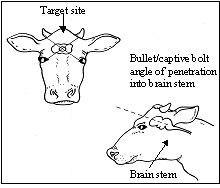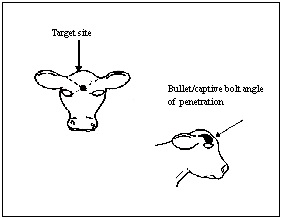On-farm euthanasia of cattle and calves
Learn questions to help determine whether a cow or calf should be euthanized on-farm.
The decision to humanely end the life of an animal may be necessary in cases of severe injury or disease or as a result of disasters such as fire or flood. On-farm euthanasia may be the most practical and humane way for a livestock producer to relieve an animal's pain and suffering if it is unfit to travel, or to prevent drug residues from entering the food supply.
Whenever possible, livestock producers should consult with a veterinarian before deciding to euthanize an animal. The following questions will help in deciding whether to treat, slaughter or euthanize an animal that is injured, extremely weak or disabled:
- Is the animal in pain or distress? If yes, consider treatment.
- Is the animal likely to recover? If yes, consider treatment.
- Does the animal have the ability to access feed and water? If yes, consider treatment.
- Have medications been administered? If yes, check withdrawal period.
- Have drug withdrawal times been cleared? If yes, consider slaughter.
- Can the animal be humanely transported? If yes, consider slaughter; you will need a veterinary certificate to transport the animal.
- Does the animal show any clinical signs that you don't recognize or that you recognize as a reportable disease? If yes, you must contact your veterinarian.
Methods of euthanasia
Euthanasia must be performed in a way that minimizes fear and anxiety in the animal. Good stockmanship practice dictates that producers have an ethical and moral responsibility to provide a humane death for animals in their care, without causing additional pain or suffering.
There are three basic methods appropriate for on-farm euthanasia: overdose by barbiturate; stunning with a penetrating captive bolt, followed by bleed-out; and gunshot. Each method has advantages and disadvantages. Euthanasia by barbiturate overdose must be performed by a veterinarian. Producers who choose the captive bolt pistol or gunshot method must take precautions to prevent serious injury to themselves and others.
To choose the most appropriate method for your operation, consider human safety, animal welfare, required skills, costs and other factors.
Table 1 outlines the three methods and considerations for each.
| Method | Human safety | Animal welfare | Skills required | Cost | Other | |
|---|---|---|---|---|---|---|
| Overdose by Barbiturate | Intravenous administration of a barbiturate | Restrain the animal | Excellent rating | Proper technique for intravenous injection | Veterinary fee | Can only be administered by licenced veterinarian. Information your deadstock collector of the drug residue in the carcass |
| Penetrating Captive Bolt | Penetration of the skull and brain by captive bolt, followed with bleed-out by cutting all the main arteries and veins in the neck | Restrain the animal. Be cautious of falling or thrashing animals | Good rating. Correct cartridge strength, target site and penetration angle on animal is essential | Correct and safe use of captive bolt pistol. Correct and safe use of sharp knife | Low — after purchase of captive bolt pistol | Results in some body movement. Results in large volume of blood that requires proper disposal |
| Gunshot | Penetration of the skull and brain by bullet | Restrain the animal. Be cautious of falling or thrashing animals. Be extremely cautious about bullet ricochet | Good rating. Correct size of firearm and ammunition, and correct target site and penetration angle on animal is essential | Correct and safe use of firearm | Low — after purchase of firearm | Results in some body movement and blood. Requires firearm acquisition certificate. Local by-laws may prohibit the use of firearms |
Penetrating captive bolt and gunshot
An experienced person can produce rapid unconsciousness in an animal by using a penetrating-type captive bolt or shot from a firearm which is aimed at the correct target site and penetration angle for the species and age of animal. The same anatomical targets and penetration angles are used for both a penetrating captive bolt pistol and a firearm (see Figure 1 and Figure 2).
Penetrating captive bolt
- Ensure the animal is well restrained.
- Use the appropriate cartridge strength for the animal (refer to the manufacturer's manual).
- Place the captive bolt pistol firmly against the animal's head on the target site, and shoot.
- Be careful to avoid injury from thrashing limbs when the animal collapses.
- Cut both the carotid arteries and jugular veins in the neck with a sharp knife to bleed-out the animal after stunning. These arteries and veins are on both sides of the throat.
Gunshot
- Ensure the animal is well restrained.
- Plan to shoot outdoors when possible.
- Have a backstop (for example, an earth berm, manure pile, or something that will stop the bullet if you miss or it over-penetrates) behind the area you are aiming at.
- Use a firearm and ammunition that are appropriate for the size, age and type of animal. The ammunition used to euthanize an animal must be powerful enough to make the animal immediately unconscious and to penetrate the head deeply enough to destroy the areas of the brain that control breathing and circulation.
- A shotgun using Buckshot cartridges that contain 6 pellets weighing a total of 30 g, or a 9 mm or a .357 calibre firearm, can be used to successfully euthanize most cattle older than six months. A larger calibre firearm will be needed for large bulls.
- For calves aged six months and younger, .22 calibre "long-rifle" hollow-nosed ammunition is generally adequate.
- Hold the firearm 5-25 cm (2-10 in.) from the target site. To avoid personal injury, do not place the firearm muzzle against the animal's skull. Aim the shot down the line of the spine so that the bullet will enter the brain stem (the beginning of the spinal cord), and shoot.
- Be careful to avoid injury from thrashing limbs when the animal collapses.
Target site and penetration angle
For cattle older than six months, the captive bolt or gunshot should penetrate the skull at the intersection of lines extending from the lower base of each side of the horn bed to the inside corner of the opposite eye as shown in Figure 1.
For calves six months of age and younger, direct the shot at the intersection of lines drawn from the top base of each ear to the inside corner of the eye on the opposite side of the head (see Figure 2).
Confirmation of death
It is essential that you confirm the animal's death directly following euthanasia. A standing animal should immediately collapse. Its muscles may involuntarily contract, usually for no longer than 20 seconds. After this, it may show some poorly co-ordinated kicking or paddling movements before the muscles completely relax.
Check the animal for breathing, heartbeat and blinking response (corneal reflex). There should be none. The eyes should be fixed and dilated. To check the blinking response, touch the surface of the animal's eye (the cornea). Any eye movement or blinking shows sustained or recovering brain activity. If there is any sign of breathing, heartbeat or blinking, repeat the euthanasia method or use an alternate procedure.
Disposal of mortalities
The proper disposal of livestock mortalities is critical in preventing environmental contamination and the spread of disease. In Ontario, the Nutrient Management Act and the Food Safety and Quality Act regulate the disposal of dead farm animals, and any parts, including blood.
Under the Nutrient Management Act regulation, producers are required to properly dispose of on-farm mortalities in a safe, environmentally friendly manner within 48 hours of death. When euthanizing an animal, it is a good idea to choose a location where you can easily reach the mortality and to quickly dispose of it.
Acceptable means of on-farm disposal under the NMA include burial, incineration, composting, disposal vessels, or anaerobic digestion. Owners may also take deadstock to common bins, waste disposal sites approved under the Environmental Protection Act, disposal facilities licensed under the FSQA, or to a licensed veterinarian for post mortem. The mortality may also be picked up by a collector licensed under the FSQA. OMAFRA has produced a number of fact sheets that explain the new requirements for each disposal method, and you may refer to the link below for further information.
While the NMA and FSQA requirements do not require prior permitting or licensing for cattle producers who transport their own deadstock to a receiver, there are additional changes under the federal Specified Risk Material regulations. As of July 12, 2007, federal regulations require any cattle deadstock moved off-farm to be stained with a visible stripe applied down the back of each carcass. Any raw SRM removed from a carcass must also be dyed. Prior to moving any SRM, including cattle deadstock, off-farm a permit must be obtained from the CFIA. The application form is available through the. The permits are free, issued for 90 days, and may involve an on-farm inspection by CFIA staff.
It is anticipated that dead animal collectors will assume responsibility for applying the stripe prior to removal of carcasses. Nonetheless, cattle producers who normally use the services of a dead animal collector are advised to discuss this with their service provider.
Conclusion
Human safety and animal welfare must over-ride economic considerations when deciding if, how, when and where an animal must be humanely destroyed.
Euthanasia, although an unpleasant task, is an inevitable component of animal husbandry. Careful planning and training can help to minimize a person's stress associated with carrying out this necessary act, and prevent the unnecessary suffering of animals. Discuss euthanasia options for your farm operation with your veterinarian, then develop an action plan and update it annually as part of your herd health program.
Notice and disclaimer
The Ministry of Agriculture, Food and Rural Affairs does not recommend any specific one of the methods described above. Producers must determine which method is appropriate for their individual circumstances. Possession and use of firearms are governed by federal legislation; producers should ensure compliance with all legislative requirements and ensure adequate safety precautions are used. OMAFRA is not liable for injuries or damages resulting from the use of the above methods.
References
Humane Slaughter Association and Council of Justice to Animals. 2001. Captive Bolt Stunning of Livestock — Guidance Notes No. 2, 3rd Edition. United Kingdom.
Humane Slaughter Association and Council of Justice to Animals. 2001. Humane Killing of Livestock Using Firearms — Guidance Notes No. 3. United Kingdom.
Ontario Pork. On-Farm Euthanasia of Swine: Options for the Producer.
Shearer, J.K. and P. Nicoletti. 2002. Procedures for Humane Euthanasia. University of Florida, College of Veterinary Medicine.
Stull, C. and P. Hullinger. 1999. The Emergency Euthanasia of Sheep and Goats. California Department of Food and Agriculture, Animal Care Program.
Dairy Workgroup. 1998. "Section 7: Care and Handling of Animals Destined For Sale or Slaughter," Animal Care Series: Dairy Care Practices, 2nd Edition. University of California, Cooperative Extension.
Dairy Workgroup. 1998. "Section 8: Euthanasia of Animals on the Dairy," Animal Care Series: Dairy Care Practices, 2nd Edition. University of California, Cooperative Extension.

